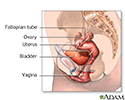Vaginal dryness alternative treatments
Alternative treatments for vaginal dryness
Information
Question:
Is there a drug-free treatment for vaginal dryness?
Answer:
There are many causes of vaginal dryness . It may be caused by reduced estrogen level, infection, medicines, and other things. Before treating yourself, talk to your health care provider.
Vaginal dryness
Vaginal dryness is present when the tissues of the vagina are no longer well-lubricated and healthy.

Water-based lubricants and vaginal moisturizers work very well. Lubricants will moisten the vaginal opening and lining for several hours. The effects of a vaginal cream can last for up to a day.
Soybeans contain plant-based substances called isoflavones. These substances have an effect on the body that is similar to estrogen, but weaker. Therefore, it would seem that a diet rich in soy foods would improve symptoms of vaginal dryness. There continues to be research in this area, but the ideal sources or dose is still unknown. Soy foods include tofu, soy milk, and whole soybeans (also called edamame).
Many women claim that creams containing wild yam help with vaginal dryness. However, there is no good research that has evaluated these creams. Also, extracts of wild yam have not been found to have estrogen- or progesterone-like activities. Some of the products may have synthetic medroxyprogesterone acetate (MPA) added. MPA is a derivative of progesterone, and is also used in oral contraceptives. Like all supplements, MPA-containing products should be used with caution.
Black cohosh is an herb that some women use as a dietary supplement to relieve menopausal symptoms. However, it is not known if this herb helps with vaginal dryness.
References
Leach MJ, Moore V. Black cohosh (Cimicifuga spp.) for menopausal symptoms. Cochrane Database Syst Rev . 2012;9. PMID: 22972105 www.ncbi.nlm.nih.gov/pubmed/22972105 .
Reed SD, Newton KM, LaCroix AZ, Grothaus LC, Grieco VS, Ehrlich K. Vaginal endometrial, and reproductive hormone findings: randomized, placebo-controlled trial of black cohosh, multibotanical herbs, and dietary soy for vasomotor symptoms: the Herbal Alternatives for Menopause (HALT) Study. Menopause . 2008;15(1):51-58. PMID: 18257142 www.ncbi.nlm.nih.gov/pubmed/18257142 .
Wilhite M. Vaginal dryness. In: Rakel D, ed. Integrative Medicine . 3rd ed. Philadelphia, PA: Elsevier Saunders; 2012:chap 56.
-
Female reproductive anatomy - illustration
External structures of the female reproductive anatomy include the labium minora and majora, the vagina and the clitoris. Internal structures include the uterus, ovaries and cervix.
Female reproductive anatomy
illustration
-
Uterus - illustration
The uterus is a hollow muscular organ located in the female pelvis between the bladder and rectum. The ovaries produce the eggs that travel through the fallopian tubes. Once the egg has left the ovary it can be fertilized and implant itself in the lining of the uterus. The main function of the uterus is to nourish the developing fetus prior to birth.
Uterus
illustration
-
Normal female anatomy - illustration
The vagina is a thin-walled tube which lies between the bladder and rectum. It is often called the birth canal, since it provides the passageway of delivery of an infant.
Normal female anatomy
illustration
-
Female reproductive anatomy - illustration
External structures of the female reproductive anatomy include the labium minora and majora, the vagina and the clitoris. Internal structures include the uterus, ovaries and cervix.
Female reproductive anatomy
illustration
-
Uterus - illustration
The uterus is a hollow muscular organ located in the female pelvis between the bladder and rectum. The ovaries produce the eggs that travel through the fallopian tubes. Once the egg has left the ovary it can be fertilized and implant itself in the lining of the uterus. The main function of the uterus is to nourish the developing fetus prior to birth.
Uterus
illustration
-
Normal female anatomy - illustration
The vagina is a thin-walled tube which lies between the bladder and rectum. It is often called the birth canal, since it provides the passageway of delivery of an infant.
Normal female anatomy
illustration
-
Menopause
(Alt. Medicine)
-
Menopause
(In-Depth)
-
Sexual dysfunction
(Alt. Medicine)
-
Acne
(Alt. Medicine)
-
Urinary incontinence
(Alt. Medicine)
-
Black cohosh
(Alt. Medicine)
-
Amenorrhea
(Alt. Medicine)
-
Ovarian cancer
(In-Depth)
-
Sinusitis
(In-Depth)
Review Date: 11/5/2015
Reviewed By: Cynthia D. White, MD, Fellow American College of Obstetricians and Gynecologists, Group Health Cooperative, Bellevue, WA. Also reviewed by David Zieve, MD, MHA, Isla Ogilvie, PhD, and the A.D.A.M. Editorial team.



